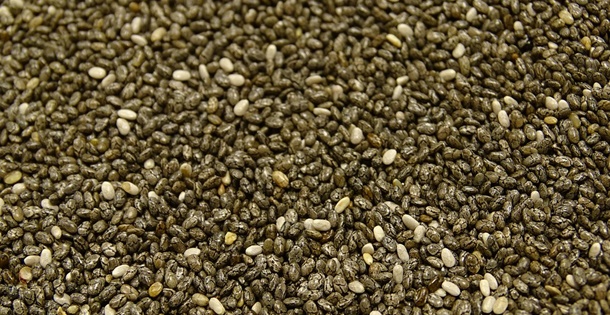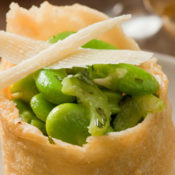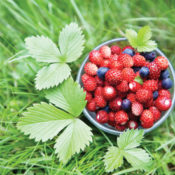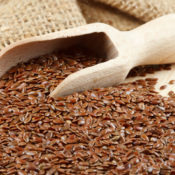For years nutritional scientists talked up dietary fiber as the key to better health, and now they are onto something even bigger and better. Whole grains, with their heart disease-fighting properties and the combined synergistic health effects of their phytochemicals and nutrients, can provide powerful protection from modern diseases and even help people stay slim. Although whole grains such as wheat, oats, and rye are all healthful, they are not all created equal. Recently, a handful of researchers around the world have been studying one of the lesser known but potentially most beneficial of all whole grains, the white-seed variety of the Salvia hispanica plant.
Once a favorite food of the ancient Aztecs who believed it increased their stamina, Salvia hispanica ranks among the richest of grains in omega-3s, dietary fiber, calcium, iron, and antioxidants.
“This grain’s nutrient composition seems phenomenal,” says Dr. Vladimir Vuksan, director of the Risk Factor Modification Centre at Toronto’s St. Michael’s Hospital. “Its health benefits are becoming more and more apparent with emerging scientific evidence.”
In the first major study of Salvia hispanica, Dr. Vuksan and his University of Toronto colleagues baked the mild-flavored grain into white bread and assessed its effects in patients with well-controlled diabetes. They used the Peruvian-grown variety of white Salvia hispanica called Salba, noted for its superior and consistent nutrient composition. Subjects eating Salba for three months (compared to controls eating wheat-bran bread) had a dramatic six-point reduction in blood pressure and a 40 percent decrease in C-reactive protein levels, the inflammation marker that is a predictor of heart disease. Most important, Dr. Vuksan points out, the patients enjoyed eating the Salba bread, suggesting that it might help overcome a major hurdle in treating diabetes patients’ dietary compliance.
At the University of Antwerp in Belgium, independent researchers found similar improvements when healthy people added Salba to their diets for one month. Data showed reductions in blood pressure and triglyceride levels, but also that the subjects’ waistlines became smaller, even though none of them lost weight. “There was no change in total body weight,” Dr. Vuksan says, “but there was a difference in waist circumference, which indicates a change in body composition.”
In effect, the whole grain appeared to be selectively reducing visceral fat. “This is important,” Dr. Vuksan stresses, “because accumulating fat around the belly is the main problem with respect to developing heart disease and especially diabetes. Once we have this ‘spare tire’ around our belly, we get into trouble.”
The Toronto researchers have since identified further Salba potential. They found “impressive glucose-lowering effects of up to 40 percent” after meals, depending on how much Salba bread was eaten, Dr. Vuksan says. On average, each gram of Salvia hispanica reduces blood sugar levels by 2 percent.
Flax, which has a similar makeup and even more viscous dietary fiber, lowers blood sugar by about half that much, notes Dr. Vuksan. “We actually know the reason for this difference,” he explains. “The soluble fiber of Salba, although less than found in flax, is much more viscous on a per-gram basis. It has the ability to gel stronger with food in the gastrointestinal tract where it slows the absorption of nutrients in the small intestines. All the food will be absorbed, but the increased length of time means the glucose level will not go as high after eating Salba-enriched starchy foods.”
Dr. Vuksan also says that Salba’s soft, permeable husk gels easily, whereas flax husk is hard. Salba can be consumed either as the whole seed or finely ground because both forms are equally effective in lowering glucose levels. On the other hand, he says, “I’m not sure whether one will be able to see any effect with eating whole flax.”
Most recently, a study on Salba conducted at the University of Litoral in Santa Fe, Argentina, and published in the British Journal of Nutrition adds more to the Salba resume of benefits. Rats were fed for months with a sucrose-rich diet causing them to develop metabolic syndrome and obesity. Yet their condition was reversed by adding Salba to their diet. Their triglyceride levels came down, and abdominal fat was reduced. Additionally, their blood levels of omega-3 EPA increased.
The University of Toronto researchers are planning further studies of Salba, especially for its potential to curb weight gain. A brief study of subjective satiety indicated Salba bread eaten for breakfast reduced the desire to eat by 40 to 60 percent two hours after a meal.
“Those are quite impressive results,” Dr. Vuksan says. “It’s a pretty big change with a practical amount of Salba.” Next, researchers hope to study objective satiety, giving people a Salba preload and measuring how it actually affects eating behavior for the next meal. “Clinical data to date, though preliminary, are encouraging to us,” Dr. Vuksan says, “especially at a time when everybody is looking at how to reduce food intake, lower body fat, and improve insulin sensitivity and diabetes control. After all, we all want to live forever. Maybe this ancient grain holds one of the keys.”
Related: Salba Recipes.
Become a Saturday Evening Post member and enjoy unlimited access. Subscribe now




Comments
where can i buy some salvia, andae there any recipes available. fred
Is chia, salba and salvia the same thing? If I call it chia will it be cheaper? And where can I find it?
I’ve never heard of salba; does it go by another name? How does it stack up against quinoa? Where is it produced and what native culture used it?
Quinoa is very nutritious but it has no or little omega 3. Salba which is actually white chia is one of the highest vegetable sources of omega 3 in nature. Salba also has more fiber than Quinoa 4.2g per 12 grams where as Quinoa has 7g per 100 grams dietary fiber. Salba is also higher in folate magnesium and is very high in antioxidants. Salba blows Quinoa out of the water for its nutrient denseness.
Salba is grown in Peru and Argentina and is now being grown in Australia where it is used in a highly nutritious bread. Like quinoa the ancient Aztecs used chia (salba). They called it their “running food” because message runners could run all day on the energy from just a handful of the seed. That’s the story anyway.